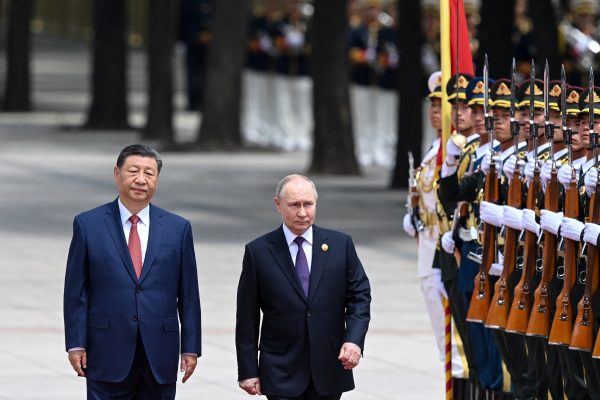In dismissing fears that Ukraine’s Crimean peninsula would be sacrificed to improve relations with Moscow, the Trump administration has affirmed that the Kremlin’s claims of sovereignty over territory seized by force contravenes international law.
The U.S. position is an important policy principle that must be applied to Moscow’s other forceful territorial acquisitions. The capture of Crimea was a blatant form of direct and rapid annexation. But in most cases, Russia’s dissection of its neighbors has been cloaked as support for local autonomy or ethnic self-determination.
Regardless of the professed status of the seceding territorial units, Moscow controls segments of three states – Ukraine (Donetsk, Luhansk, Crimea, Sevastopol), Georgia (Abkhazia, South Ossetia), and Moldova (Transnistria). It also perpetuates Armenia’s occupation of Azerbaijan’s territory (Nagorno-Karabakh and seven other districts) and promotes separatism and inter-state disputes in the Western Balkans.
Since the collapse of the Soviet Union, Moscow has actively engineered “frozen conflicts” and the maintenance of “frozen states” in order to paralyze central governments and prevent countries from joining Western institutions. The Kremlin seeks international legitimacy for separatist enclaves that it has overtly or covertly sponsored and it acts as a mediator in avowedly resolving disputes that it does not want resolved. Moscow also holds in reserve the prospect of reviving these armed conflicts and precipitating direct military intervention. This threatening posture is intended to convince Western governments to make compromises that favor Russia.
With its occupation of Transnistria and parts of Donbas through surrogate forces that it recruits and equips, Moscow is pushing its own version of federalism on to Moldova and Ukraine. In this scheme, the secessionist regions seek a confederal arrangement with the central government and veto powers over the country’s foreign and security policies, thus blocking the countries’ entry into Western institutions. Moscow also signals that it could support statehood for the separatist territories if the governments in Kyiv and Chișinău pursue policies that impede Russia’s ambitions.
The Kremlin has taken a further step with Georgia by recognizing Abkhazia and South Ossetia as independent states. This is likely a temporary arrangement, as the Putin government is closely integrating both entities into Russia’s economic and military structures and raising the prospect of absorption by the Russian Federation. In such an arrangement, South Ossetia would unite with North Ossetia in one federal unit and Abkhazia would become another federal subject.
In Moldova, Moscow is intensifying its pressures on Chișinău with the goal of federalizing the state. Washington needs to distance itself from representatives of the OSCE (Organization for Security and Cooperation in Europe) in Moldova who continue to be duped by the Kremlin in backing a federal plan that will acknowledge the sovereignty of Transnistria and undercut Moldova’s pro-Western foreign policy. An inadequate Western response to the violent partition of Ukraine, Georgia, and Moldova simply encourages Moscow to continue this model of expansionism in other parts of the wider Europe.
Western governments must also learn lessons from Nagorno-Karabakh, where Russia has gained leverage over two states by exploiting and maintaining a conflict between them. By assisting Armenia’s occupation of Azerbaijani territory, Moscow is ensuring Yerevan’s political and military dependence. And by simultaneously acknowledging Azerbaijan’s territorial integrity, Russia dangles the prospect of regaining Nagorno-Karabakh if Baku develops closer ties with Russia. If Yerevan moves westward, Moscow can cease supporting Karabakh separatism. If Baku moves westward, Moscow can recognize the partition of Azerbaijan.
In effect, the Kremlin is determined to obstruct any resolution of this conflict, as this would widen the road toward Western institutions for both Armenia and Azerbaijan. Nagorno-Karabakh presents an opportunity for more intensive attempts at resolution by Washington because Russian forces do not occupy the territory, while a renewed war could ensnare neighboring Turkey and Iran.
Moscow is also projecting its blueprints for conflict into the Western Balkans, although with mixed results thus far. It was unable to precipitate a crisis between Montenegro and Serbia over the independence of the former or to spark inter-ethnic collisions inside Montenegro through an attempted coup d’etat in October 2016, in order to stymie NATO entry.
Nonetheless, Moscow maintains at least three key pressure points in the region. It seeks to perpetuate Macedonia as a “frozen state” by maintaining its conflict with Greece over the country’s name. Since the signing of the agreement between Athens and Skopje to resolve their dispute, Russian services have been pouring money into movements and media that can provoke anti-government demonstrations and abort the new accord.
Moscow also remains active in blocking Kosova’s path into the UN and discouraging Belgrade from forging any bilateral agreements with Prishtina. And in Bosnia-Herzegovina, the Kremlin openly backs secessionist sentiments among leaders of the Serb Republic entity as the country gears up for national elections in October. To detect and thwart any destabilizing conspiracies, local and Western intelligence services must remain on high alert, particularly for any violent provocations by Russian agencies and their proxies.




